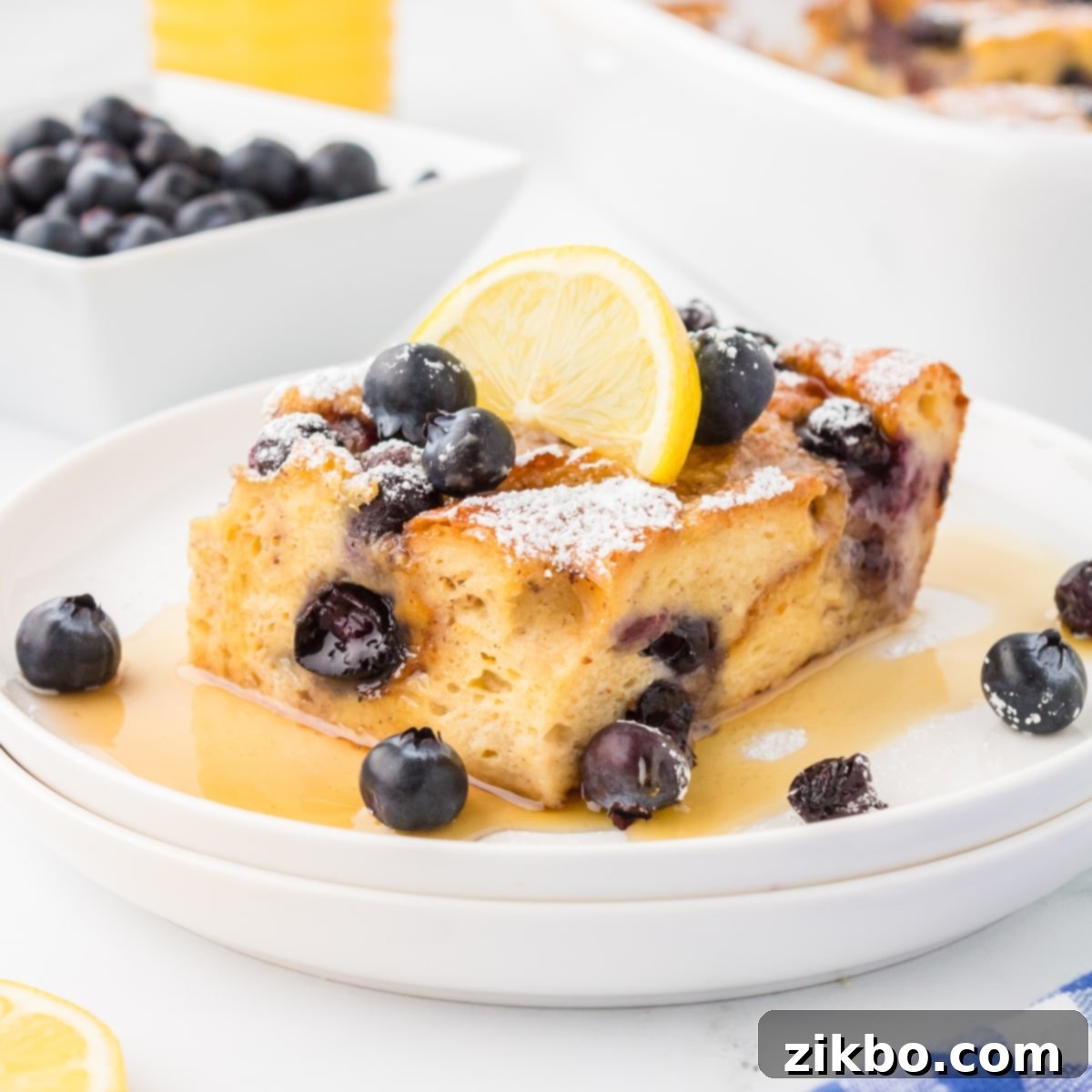Easy Make-Ahead Brioche French Toast Casserole: The Ultimate Crowd-Pleasing Breakfast & Brunch Recipe
Imagine waking up to the comforting aroma of a warm, golden-brown French toast casserole, ready to be enjoyed without the fuss of dipping individual slices. This simple yet sophisticated recipe for Brioche French Toast Casserole transforms a classic breakfast into an effortless, crowd-pleasing dish perfect for any special occasion. Whether it’s a festive holiday morning, a celebratory brunch, or a relaxed weekend gathering, this baked French toast eliminates the need for endless dipping and flipping, allowing you to spend more time with your loved ones and less time in the kitchen.
Our recipe leverages the rich, buttery texture of brioche bread, soaking it in a luscious custard mixture overnight (or for a quick soak) before baking it to a delightful golden crispness. Drizzled with warm maple syrup and adorned with fresh berries, this French toast casserole is a surefire way to bring smiles to the breakfast table. It’s the ultimate solution for serving a delicious, homemade breakfast to a crowd, offering both convenience and an unforgettable culinary experience.
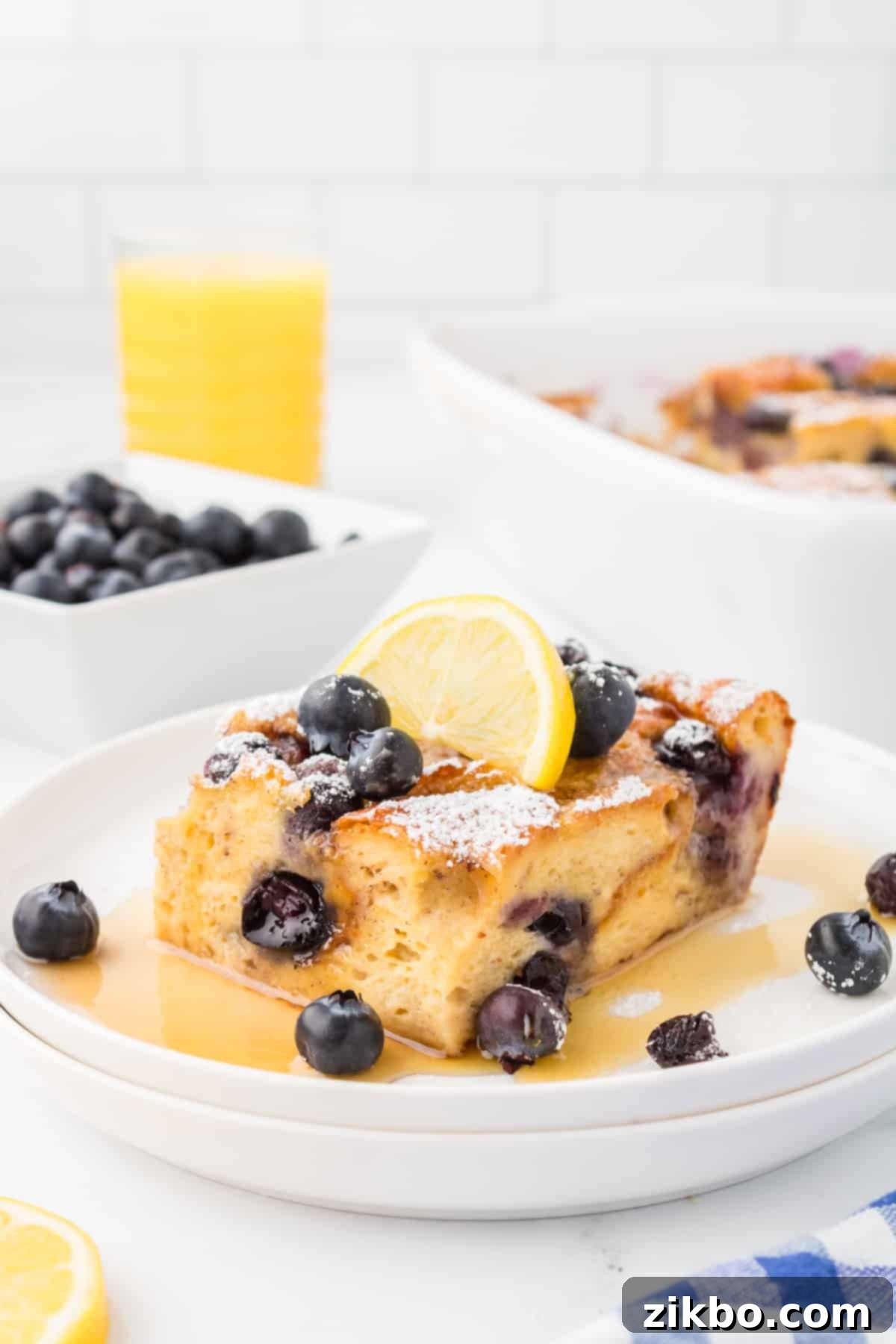
There’s nothing quite like the start of a special day marked by a delicious, homemade breakfast shared with family. The tantalizing smells of freshly-squeezed orange juice, warm maple syrup, and fluffy French toast wafting through the house are guaranteed to put anyone in a good mood. Taking that extra time early in the morning to prepare such a treat is a wonderful way to show your guests or loved ones just how much you care. This make-ahead recipe for baked brioche French toast stands out as one of my absolute favorite ways to do exactly that, offering a heartfelt gesture without the morning rush.
Why You’ll Fall in Love with This Brioche French Toast Casserole Recipe:
- Effortless Entertaining for a Crowd: Say goodbye to standing over a hot griddle, dipping and frying individual slices. This casserole is designed for easy serving to many, making it the best way to handle large breakfast or brunch gatherings. Simply prepare everything the night before, and pop it into the oven in the morning.
- Perfect for Any Special Occasion: This baked French toast is truly a showstopper. It’s an ideal dish for cherished holidays like Mother’s Day, Christmas, Easter, or Thanksgiving brunch. Its elegant presentation and comforting flavors make it a fitting centerpiece for any celebratory meal, yet it’s simple enough for a delightful weekend treat.
- A Thoughtful Gift of Comfort: Beyond special events, this easy French toast bake makes a perfect, comforting meal to share with new mothers, friends recovering from illness, or anyone who could benefit from a heartfelt, homemade dish delivered right to their door. It’s an edible hug in a pan.
- Made with Simple, Versatile Ingredients: You’ll appreciate that this recipe relies on basic ingredients you likely already have in your pantry or fridge. The fruit element, traditionally blueberries, is incredibly flexible. Feel free to swap them out for seasonal fruits, chocolate chips, or even a delightful combination of your favorite mix-ins.
- Irresistible Texture and Flavor: Brioche bread, known for its buttery richness, creates an incredibly tender, custardy interior while the baking process yields a wonderfully golden and slightly crispy top. Each bite is a harmonious blend of sweet, rich, and fruity notes, elevated by aromatic spices like cinnamon and nutmeg.
- Flexible Preparation Schedule: Note: While it truly shines as a make-ahead, overnight dish, you absolutely have the option to prepare and bake it on the same day! Just allow for a quick, minimum one-hour soak before baking to ensure the bread absorbs enough of the custard for that perfect texture.
Ingredients You’ll Need
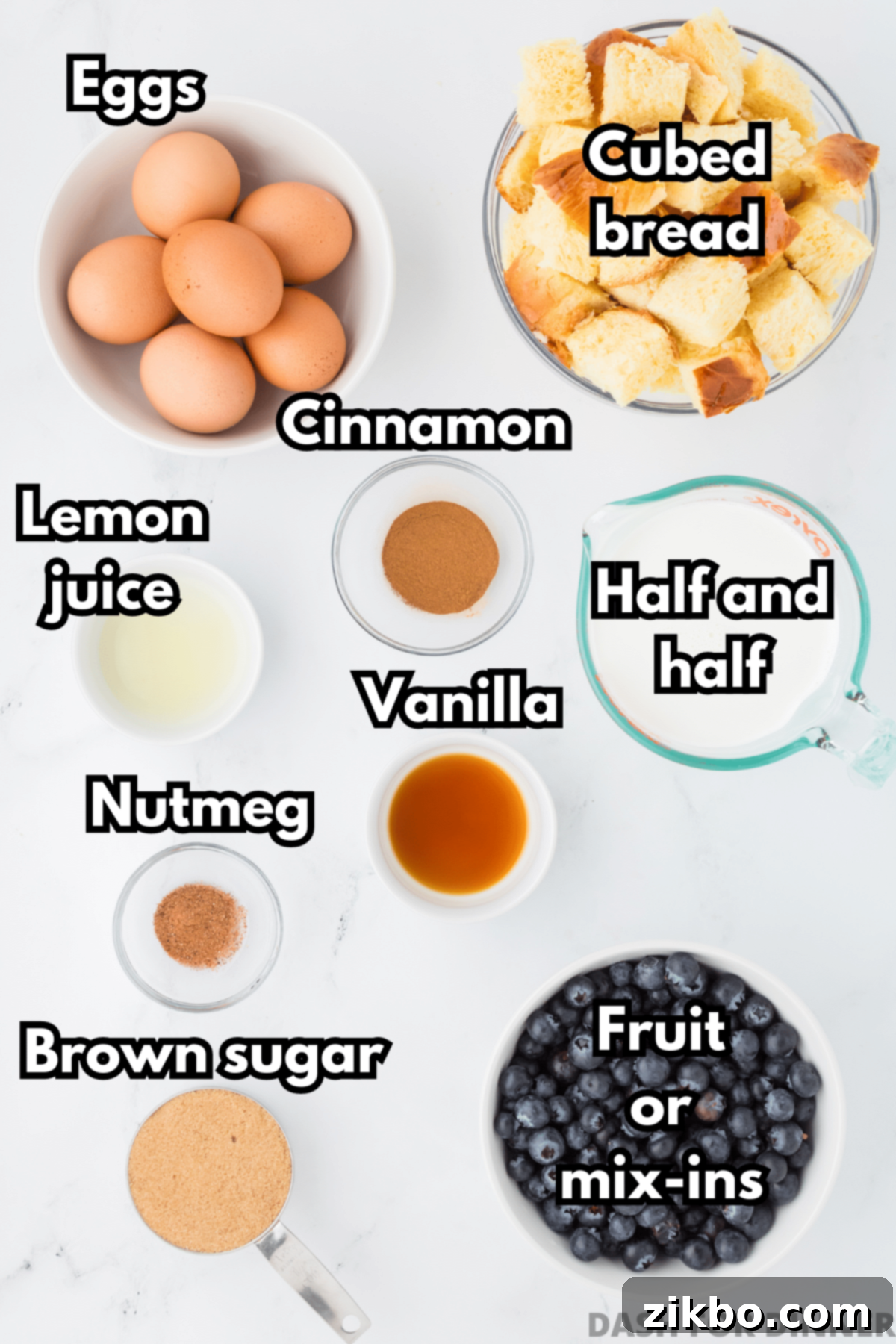
Creating this magnificent Brioche French Toast Casserole requires a few key components. Each ingredient plays a vital role in achieving that perfect balance of sweetness, richness, and custardy goodness:
- Cubed Brioche Bread: This is the undeniable star of our casserole. Approximately one loaf of buttery brioche bread, cut into 1 ½-inch cubes (about 14 ounces), provides the ideal foundation. Brioche’s high butter and egg content makes it incredibly rich and tender, holding up beautifully to the soaking liquid without becoming mushy.
- The Secret to Success: Dry or Stale Bread is Best! For optimal absorption of the custard, bread that is a day or two old, or slightly dry/stale, works wonders. If your brioche is super fresh, don’t worry! You can easily dry it out a bit:
- Spread the cubed bread evenly on a baking sheet.
- Bake at 275ºF (135ºC) for 5-10 minutes, or until the cubes feel crusty but aren’t browned.
- Remove from the oven and let them cool briefly before incorporating into the casserole. This simple step ensures maximum absorption and a truly custardy final product.
- Substitution Tip: While brioche is highly recommended, other sturdy, bakery-style loaves like challah, French bread, or even a good quality sourdough (for a tangier note) can be used. Avoid very soft sandwich bread, as it tends to disintegrate when soaked.
- The Secret to Success: Dry or Stale Bread is Best! For optimal absorption of the custard, bread that is a day or two old, or slightly dry/stale, works wonders. If your brioche is super fresh, don’t worry! You can easily dry it out a bit:
- Half and Half: This dairy staple is crucial for creating a rich, creamy custard without making the casserole overly heavy. It strikes the perfect balance between whole milk and heavy cream.
- DIY Half and Half: If you don’t have half and half on hand, you can easily make your own by combining equal parts whole milk and heavy cream. For this recipe, that would be 1 ½ cups of whole milk and 1 ½ cups of heavy cream to substitute for the 3 cups of half and half.
- Large Eggs: The binding agent of our custard! Eggs are essential for setting the casserole and creating that signature custardy texture. Ensure they are well-beaten to incorporate air and ensure a smooth mixture.
- Blueberries (or Your Choice of Mix-Ins): Fresh blueberries are a classic pairing with French toast, adding bursts of sweet-tart flavor and vibrant color. However, this recipe is incredibly versatile. Feel free to get creative and swap them out, or add to them, with other delicious options:
- Other Fresh Berries: Sliced strawberries, raspberries, or blackberries.
- Sweet Indulgences: Chocolate chips (milk, dark, or white), chopped nuts (pecans, walnuts, almonds), or even a swirl of cream cheese or Nutella.
- Other Fruits: Sliced bananas, diced apples, or pears (you might want to lightly sauté harder fruits first).
- Other Flavor Enhancers: You’ll also need a few key pantry staples to round out the flavor profile:
- Packed Brown Sugar: For a deep, caramel-like sweetness.
- Vanilla Extract: To add a warm, aromatic depth.
- Ground Cinnamon and Nutmeg: These classic spices infuse the casserole with cozy, comforting warmth that perfectly complements the bread and fruit.
- Fresh Lemon Juice: A small amount of lemon juice might seem surprising, but it adds a subtle brightness that cuts through the richness and enhances the overall flavor profile. Don’t skip it!
For Serving (Optional but Highly Recommended)
While delicious on its own, a few simple additions can elevate your French toast casserole to dessert-like decadence:
- Powdered sugar (dusted generously for a beautiful finish)
- Pure maple syrup (warm is best!)
- Lightly sweetened whipped cream
- Extra fresh berries or sliced fruit
For precise measurements and a full breakdown, please refer to the detailed recipe card at the end of this article.
How to Make This Dreamy French Toast Casserole
Whether you’re planning a grand holiday brunch or simply seeking a great recipe for stress-free weekend mornings, this French toast casserole recipe is an undeniable winner that the whole family will adore for its ease and incredible flavor!
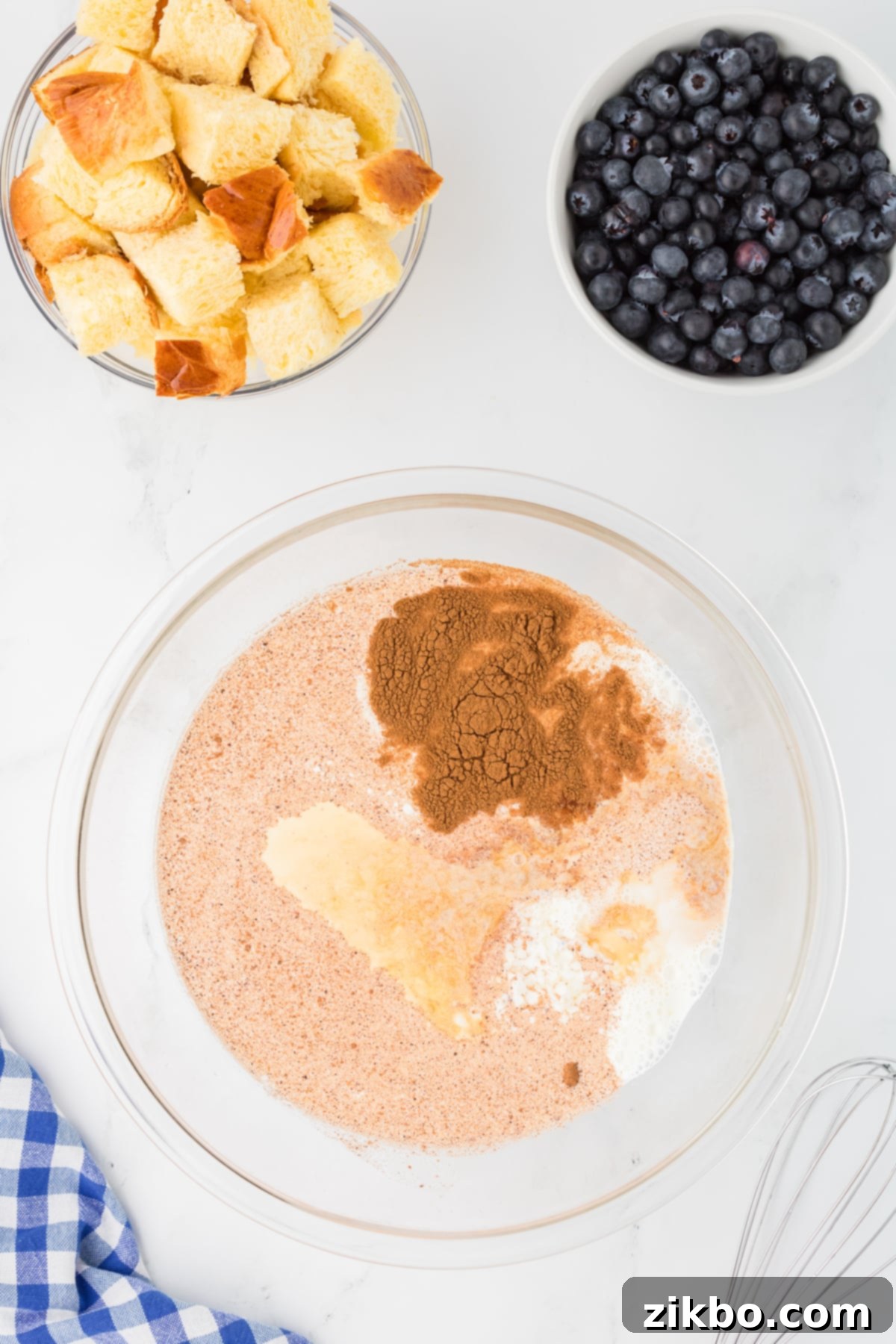
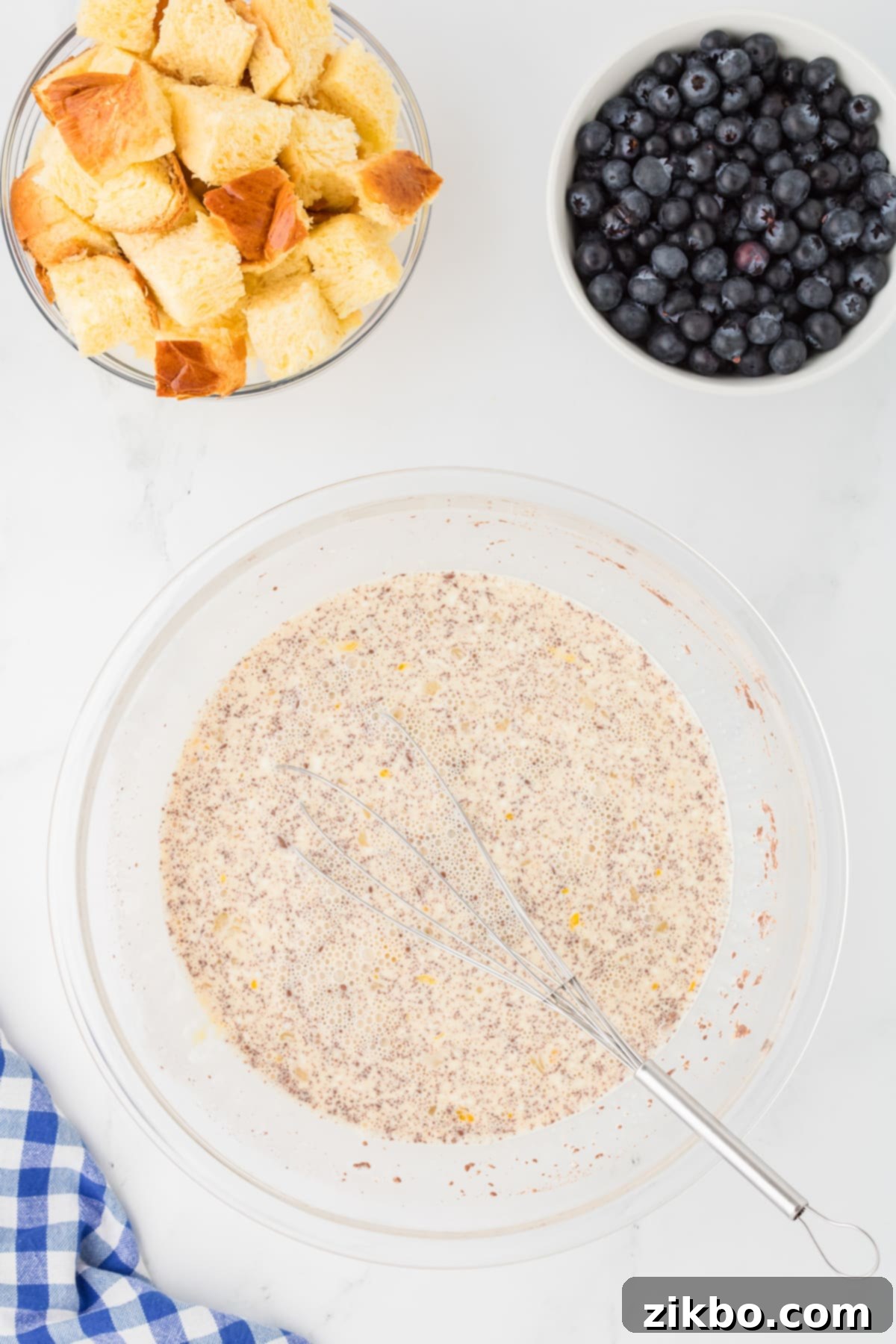
Step One: Prepare the Custard Base. In a large mixing bowl, combine the eggs, half and half, brown sugar, lemon juice, vanilla extract, ground cinnamon, and nutmeg. These ingredients will form the rich, aromatic custard that imbues the brioche with its signature flavor and texture.
Step Two: Whisk to Perfection. Whisk the mixture vigorously until all ingredients are well combined and the eggs are thoroughly beaten. You want a smooth, uniform custard with no visible streaks of egg yolk or white. This ensures an even soak and consistent texture throughout the casserole.
Adding the Bread Cubes and Berries
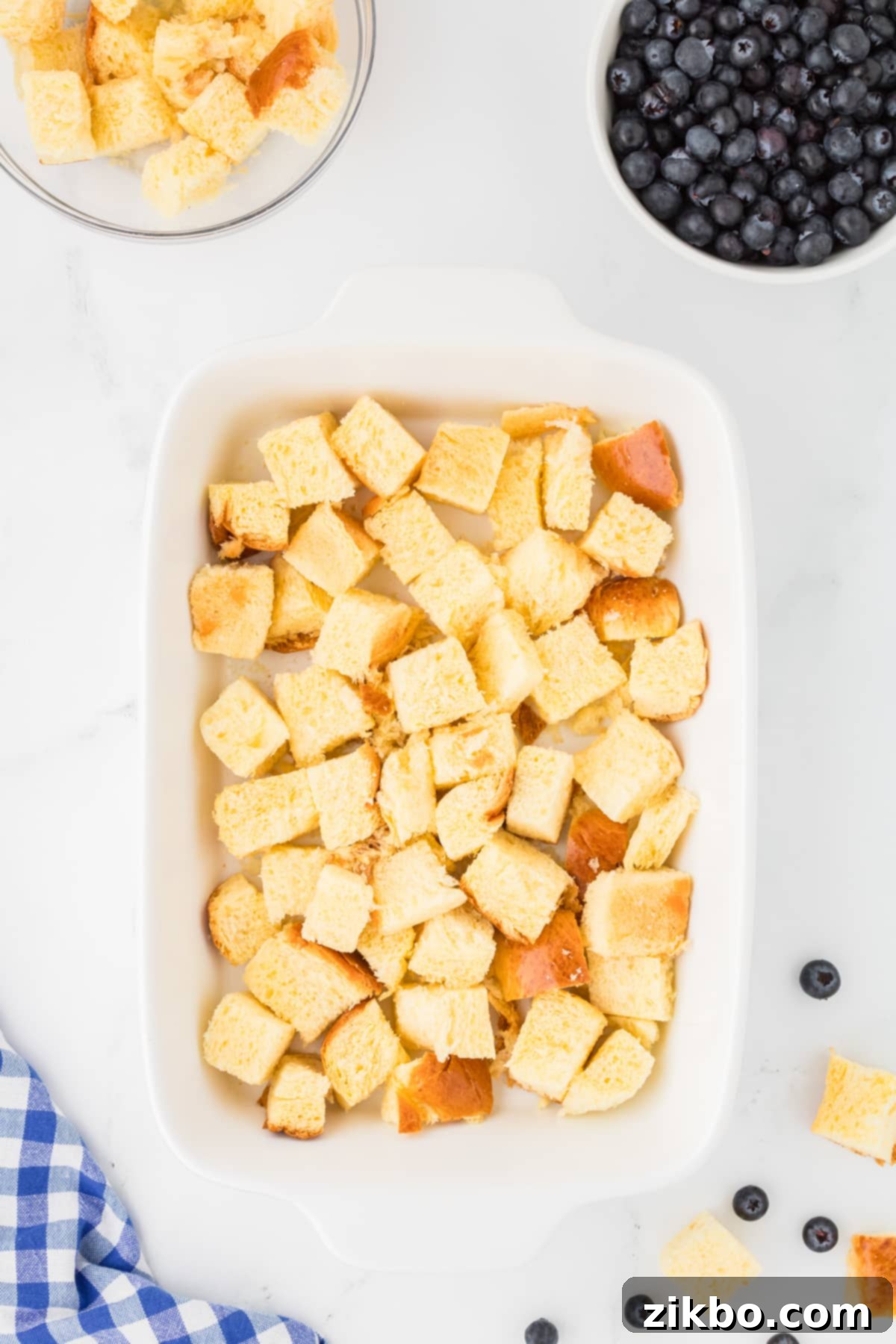
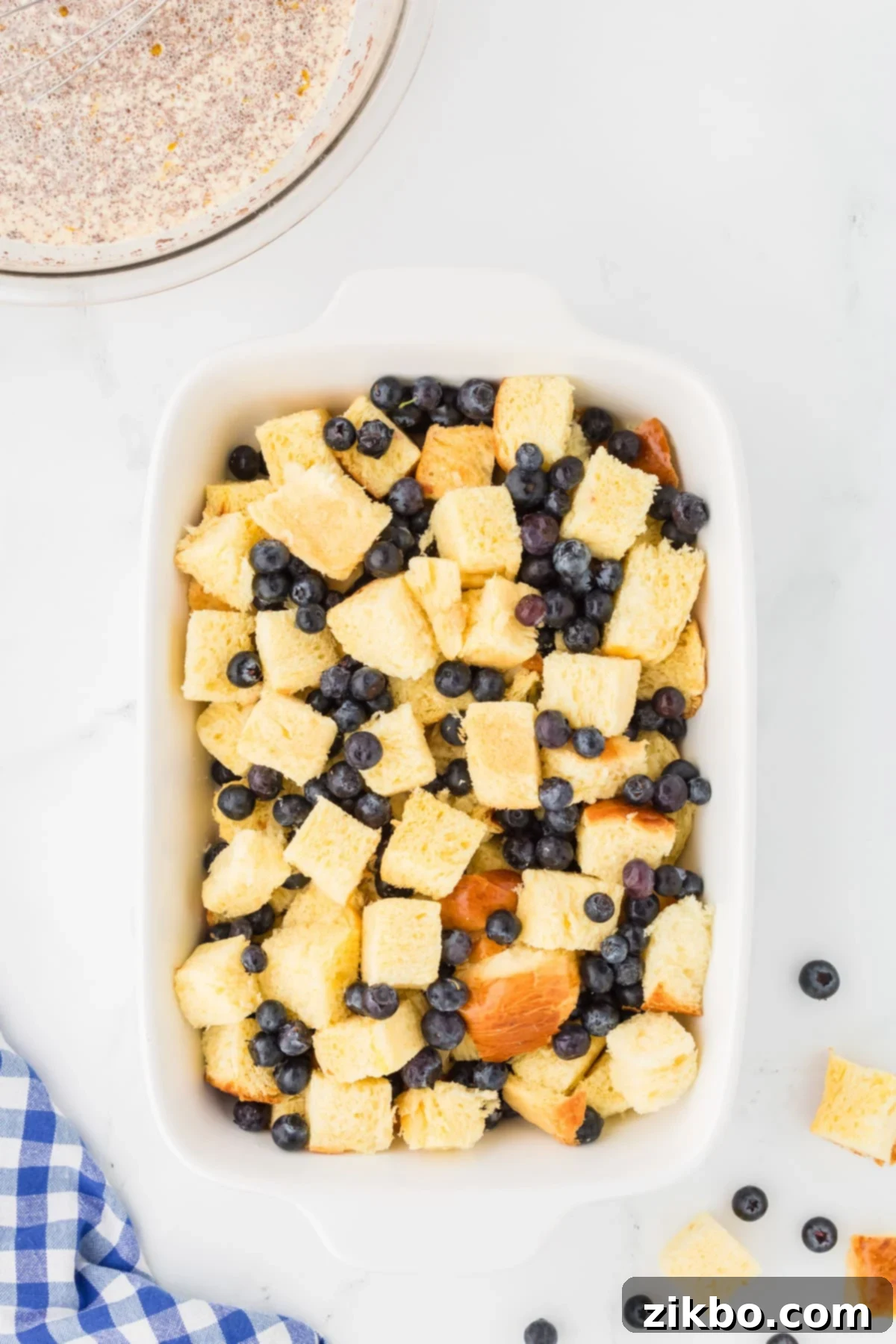
Step Three: Layer the Bread. Lightly grease a 9X13-inch (23X33cm) baking dish. Place half of your prepared (cubed and ideally dried/stale) brioche bread cubes into the bottom of the dish, spreading them out in an even layer. This forms the foundational layer for your casserole.
Step Four: Add Berries and More Bread. Evenly sprinkle 1 cup of your blueberries (or chosen mix-ins) over the first layer of bread cubes. This ensures fruit in every bite! Next, top with the remaining bread cubes, followed by the rest of the blueberries. This layering technique helps distribute the fruit and bread evenly throughout the casserole.
Soaking and Baking for Perfection
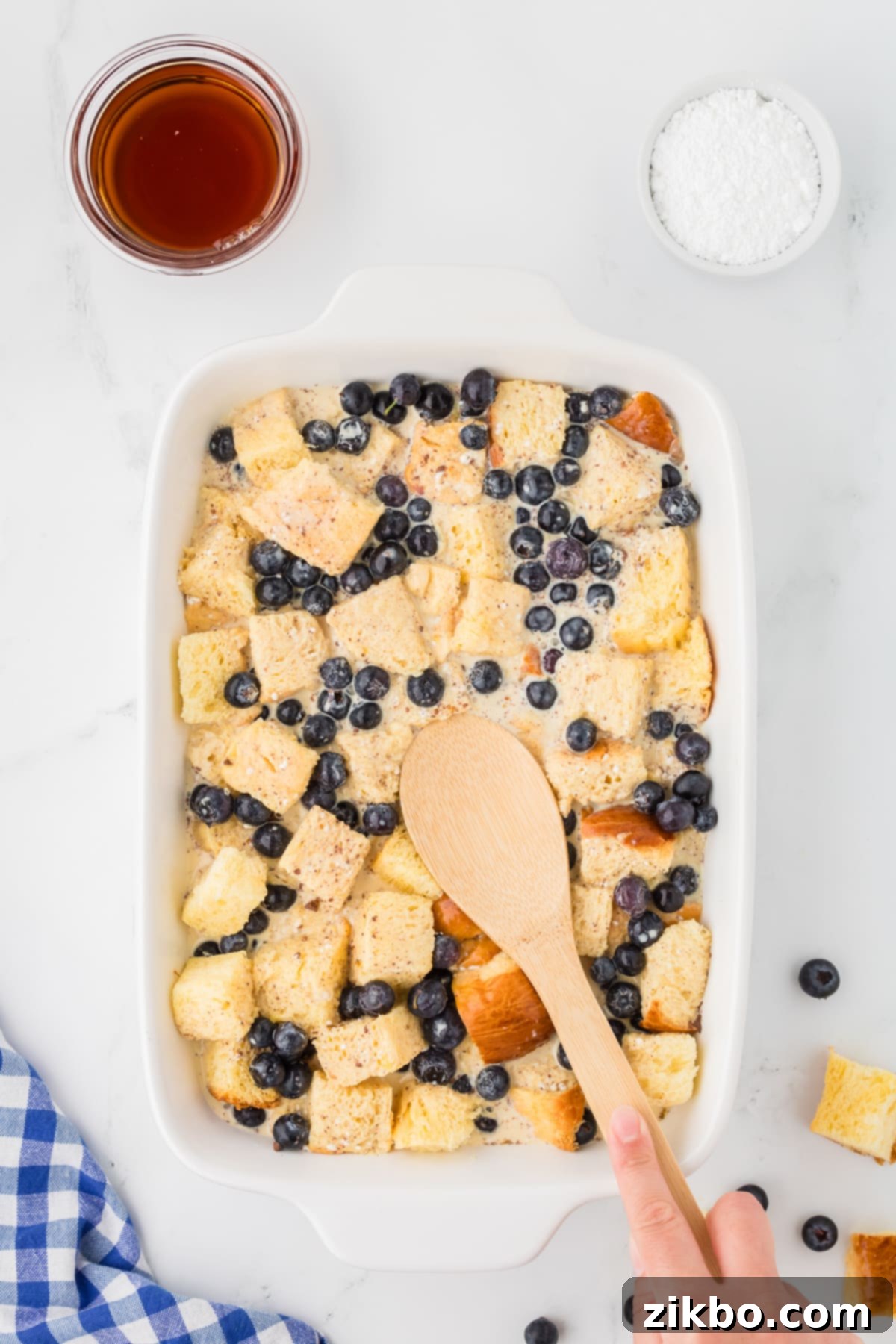
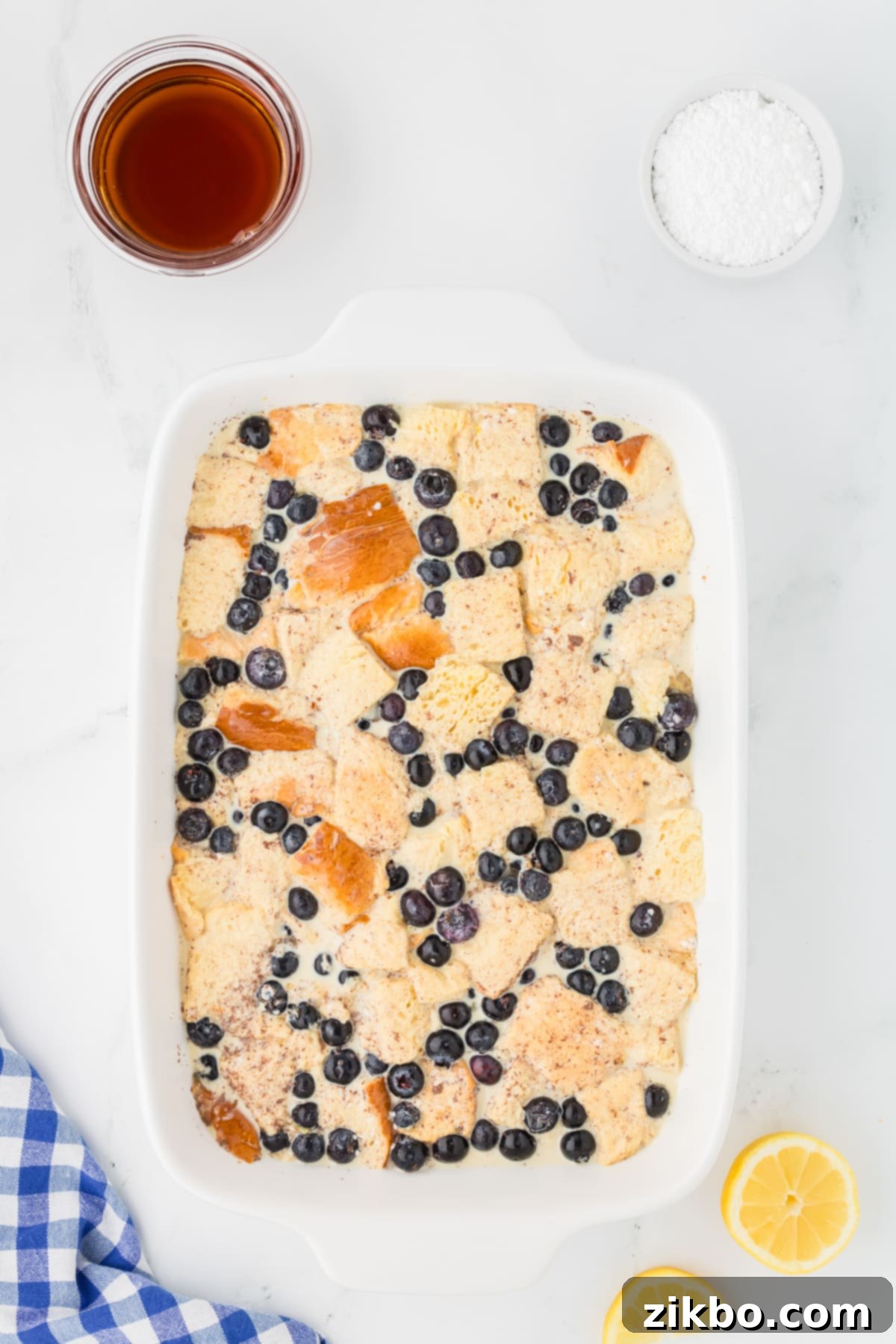
Step Five: Pour and Submerge. Carefully pour the prepared custard mixture over the bread and blueberries in the casserole dish. Use a wooden spoon or spatula to gently press down on the bread cubes, ensuring they are fully submerged and soak up the luscious liquid. This is crucial for a moist, custardy result.
Step Six: The Essential Soak. Cover the baking dish tightly with plastic wrap or aluminum foil and place it in the refrigerator. Allow the mixture to soak for at least 1 hour; however, for the absolute best flavor and texture, an overnight soak (8-12 hours) is highly recommended. This allows the brioche to fully absorb the custard, leading to an incredibly tender interior.
The Magic of Overnight French Toast Casserole
Preparing this casserole the night before is a game-changer for stress-free mornings. Simply assemble the casserole as instructed, pouring in the egg and half-and-half mixture, ensuring all bread is submerged. Cover tightly with plastic wrap or aluminum foil and place it in the fridge to soak and rest throughout the night. This extended resting period allows the flavors to meld beautifully and the bread to become incredibly saturated, resulting in a supremely custardy texture.
The next morning, for best results and to prevent any temperature shock to your baking dish, either add the cold dish directly to a cold oven before turning it on, allowing it to warm up gradually, OR let the casserole sit on the counter for 30-60 minutes to come closer to room temperature before placing it into a preheated oven.
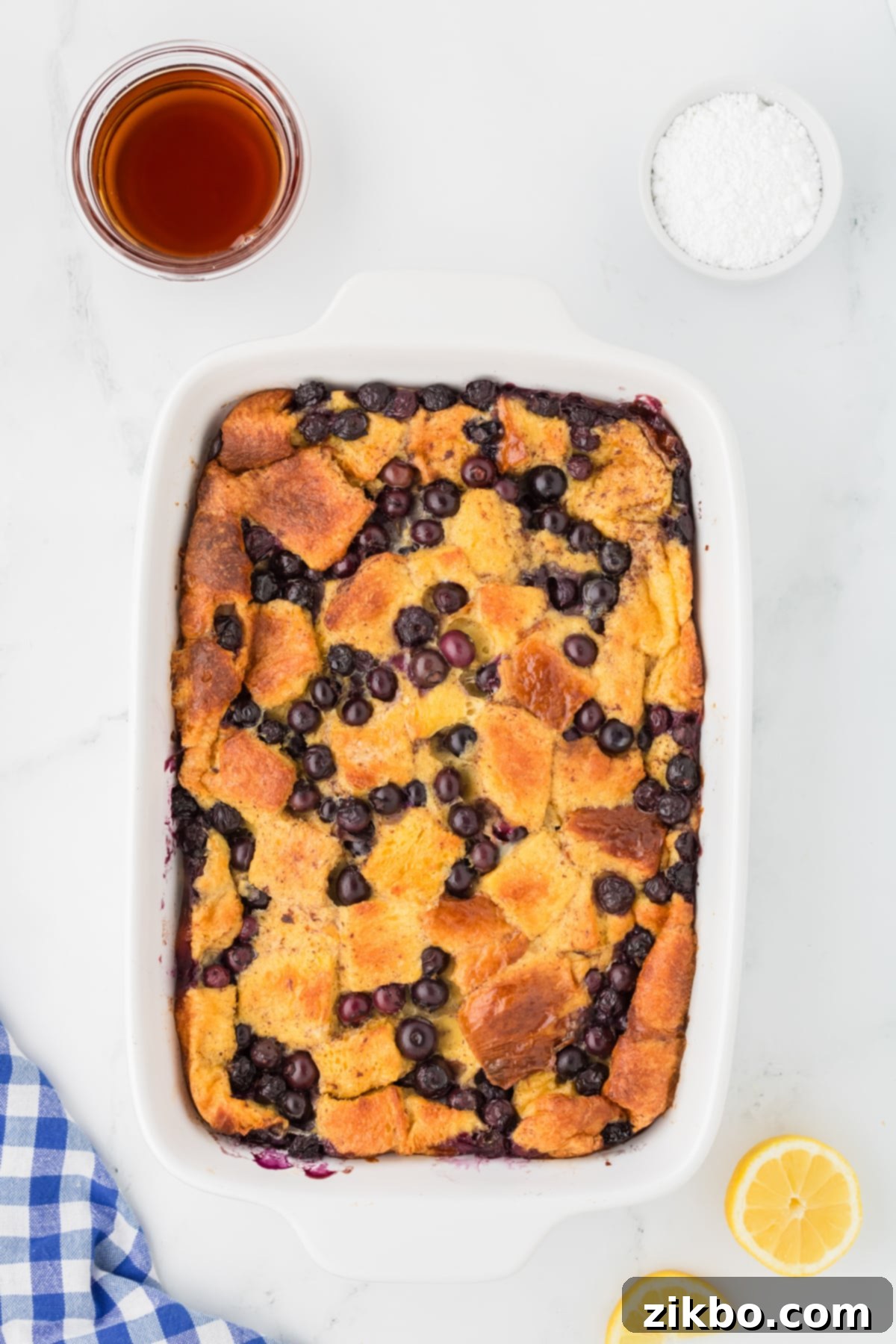
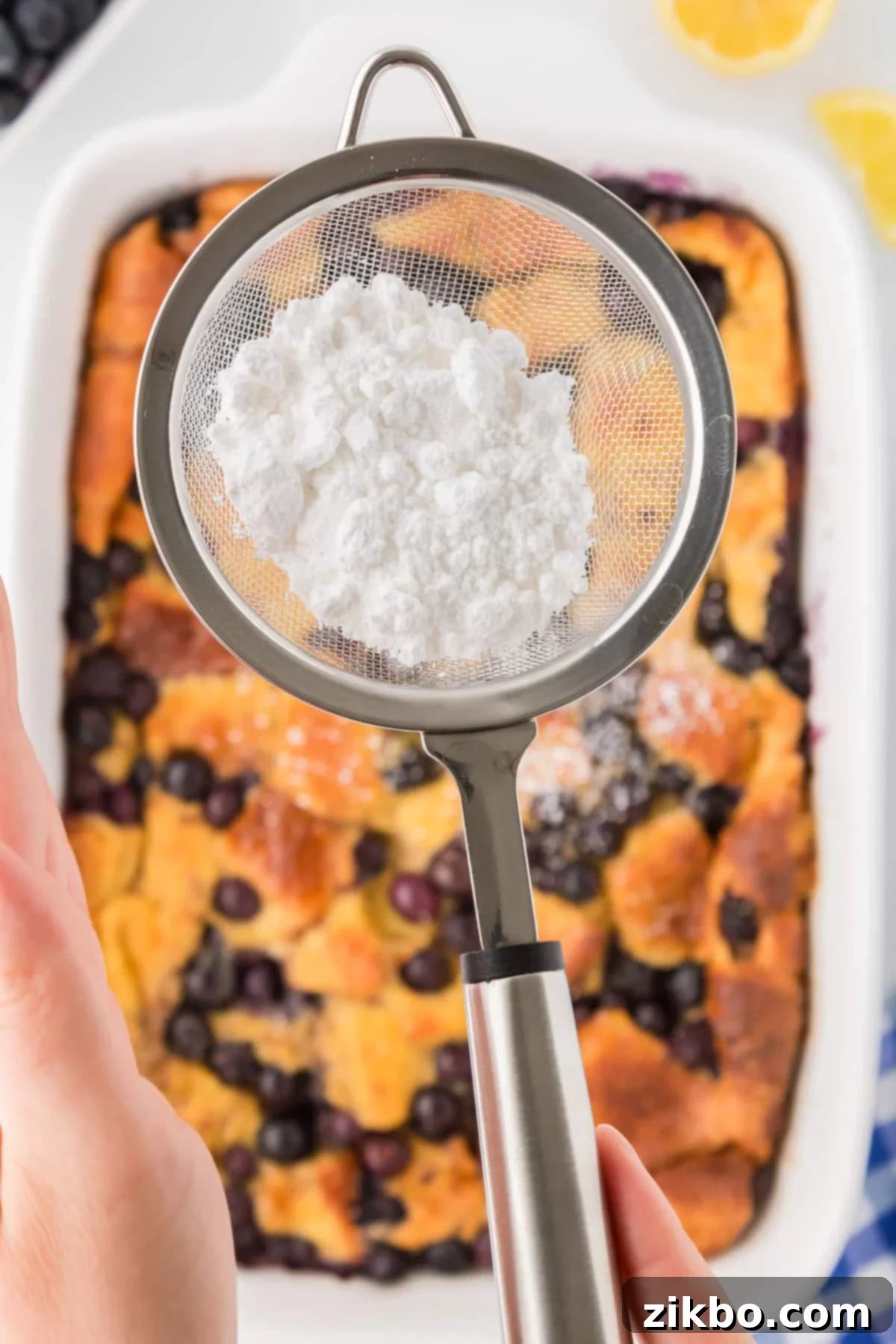
Step Seven: Bake to Golden Perfection. When you’re ready to bake, place the uncovered casserole dish into a preheated 350ºF (177ºC) oven. Bake for 45-55 minutes, or until the egg mixture is fully cooked through (it shouldn’t be runny when gently shaken) and the surface of the casserole is beautifully golden brown and slightly crispy. If the top starts to brown too quickly, you can loosely tent it with aluminum foil to prevent over-browning while the interior finishes cooking.
Step Eight: Garnish and Serve. Once baked, remove the casserole from the oven and let it rest for a few minutes. If desired, generously sprinkle with powdered sugar for an elegant finish. Slice into individual portions and serve warm. This brioche French toast casserole is absolutely divine on its own, but truly shines when paired with your choice of warm maple syrup, a dollop of whipped cream, or extra fresh berries. Enjoy!
Important Baking Tip: To prevent the possibility of temperature shock, which can sometimes cause cold ceramic or glass baking dishes to crack when placed directly into a hot oven, I highly recommend this method: place your cold casserole dish into the oven before you even turn the oven on. Then, set the oven to 350ºF (177ºC) and allow it to preheat with the casserole inside. As the oven gradually warms up, it will gently bring the casserole dish to temperature, significantly reducing the likelihood of breakage. Alternatively, let your casserole sit out at room temperature for 30-60 minutes before baking in a preheated oven.
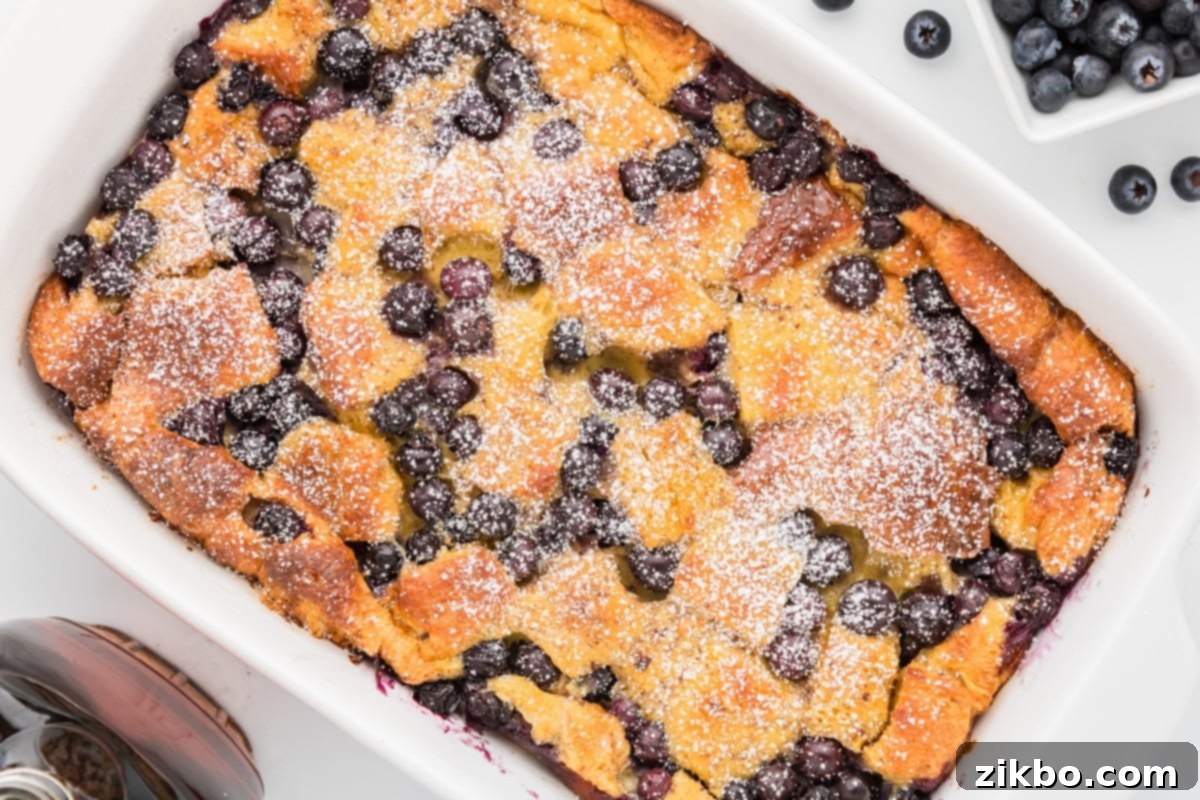
What to Serve with Your Baked French Toast Casserole
The beauty of this baked French toast casserole is its heartiness – it’s practically a complete meal in itself! It offers a satisfying and filling breakfast that can certainly stand alone. However, for those special brunches or larger gatherings, it also pairs wonderfully with a variety of side dishes, creating a truly spectacular spread.
- Savory Proteins: Complement the sweetness with classic breakfast meats like crispy bacon, savory sausages (patties or links), or slices of baked ham.
- Egg Dishes: For an extra dose of protein, scrambled eggs, a fluffy frittata, or an egg custard would be excellent additions.
- Fresh Fruit & Salads: Brighten your meal with a vibrant fruit salad, offering a refreshing contrast to the richness of the French toast. Sliced fresh berries, melons, pears, and apples are always a welcome sight.
- Potato Sides: A comforting side of crispy hashbrowns or a creamy hashbrown casserole adds another layer of indulgence.
- Beverages: Round out your brunch with refreshing smoothies, freshly squeezed orange juice, or celebratory mimosas for the adults.
Storing, Reheating, and Freezing
This casserole is fantastic fresh out of the oven, but it’s also incredibly convenient thanks to its make-ahead and easy-to-store nature. Here’s how to best manage any leftovers or prepare it for future enjoyment:
Storing Leftovers: Once the casserole has cooled completely, transfer any leftover portions to an airtight container. Store it in the refrigerator, where it will keep beautifully for up to 3 days. This makes it perfect for delicious, quick breakfasts throughout the week!
Reheating Individual Servings: For single portions, the microwave is your best friend. Heat in 30-second intervals until warmed through to your liking. If you prefer reheating in the oven, cover a slice with foil and warm at 300°F (150°C) for about 15-20 minutes, or until heated through. Don’t forget to top with fresh maple syrup, a dollop of whipped cream, and/or a dusting of powdered sugar before serving to refresh its deliciousness.
Freezing for Future Feasts: This casserole is wonderfully freezer-friendly, offering two convenient options:
- Before Baking: Assemble the casserole fully, pour the custard over the bread, cover tightly with a double layer of plastic wrap and then foil, and freeze for up to 2-3 months. When ready to bake, thaw in the refrigerator overnight, then bake according to the instructions, preferably using the cold oven method.
- After Baking: Once the casserole is baked and completely cooled, you can slice it into individual portions or freeze it whole. Wrap tightly in plastic wrap and then foil. Freeze for up to 1-2 months. To enjoy, thaw overnight in the fridge and reheat as described above for individual servings. This is fantastic for quick, indulgent breakfasts on busy mornings!
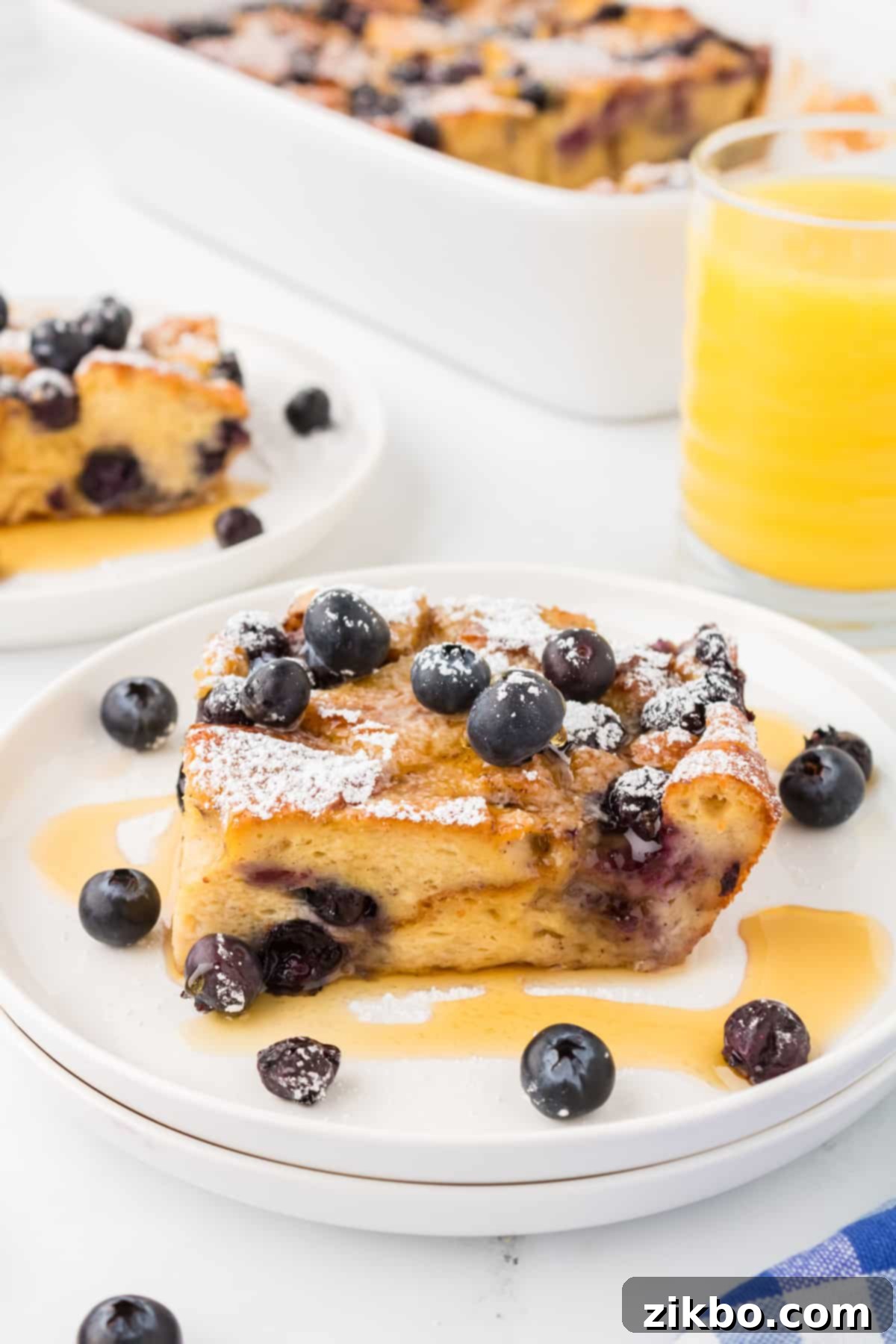
Choosing the Best Bread for Your French Toast Casserole
The type of bread you choose is paramount to the success of your French Toast Casserole. It’s not just about flavor, but also about structure and absorbency. Here’s what you need to know:
- Brioche Bread is the Star: There’s a reason brioche is the primary recommendation. Its rich, buttery, and slightly sweet nature imbues the casserole with an unparalleled depth of flavor. Its tender crumb, when slightly dried, soaks up the custard beautifully, yielding an incredibly moist and custardy interior that remains intact during baking.
- Excellent Substitutes: If brioche isn’t available or you prefer a different flavor profile, any sturdy, bakery-style bread will work well. Great alternatives include:
- Challah: Similar to brioche in richness and texture, challah is another fantastic choice for French toast.
- French Bread (Baguette): A day-old French baguette, with its crusty exterior and dense interior, makes an excellent, slightly chewier French toast casserole.
- Sourdough: For a delightful tang that balances the sweetness, sourdough bread can be a superb option.
- Plain Old Sandwich Bread (in a pinch): While not ideal due to its softer texture, if it’s all you have, make sure it’s very stale and dry to prevent sogginess.
- The Golden Rule: Dry or Stale Bread is a Must! This is perhaps the most critical tip for any French toast, especially a casserole. Bread that is a little dry or stale is essential because it acts like a sponge, allowing it to soak up all the delicious custard mixture without falling apart. If your bread is too fresh and soft, the casserole will likely turn out soggy and lack that desirable custardy texture.
- Quick Drying Method for Fresh Bread: Don’t have stale bread? No problem! You can easily speed up the drying process. Simply cube your fresh bread and spread the pieces in a single layer on a baking sheet. Bake at 275ºF (135ºC) for 5-15 minutes, or until the cubes feel firm and crusty but are not browned. Be sure to flip the bread halfway through and keep a close eye on it to prevent toasting. Remove and let cool slightly before using. This simple step ensures your casserole will have the perfect texture.
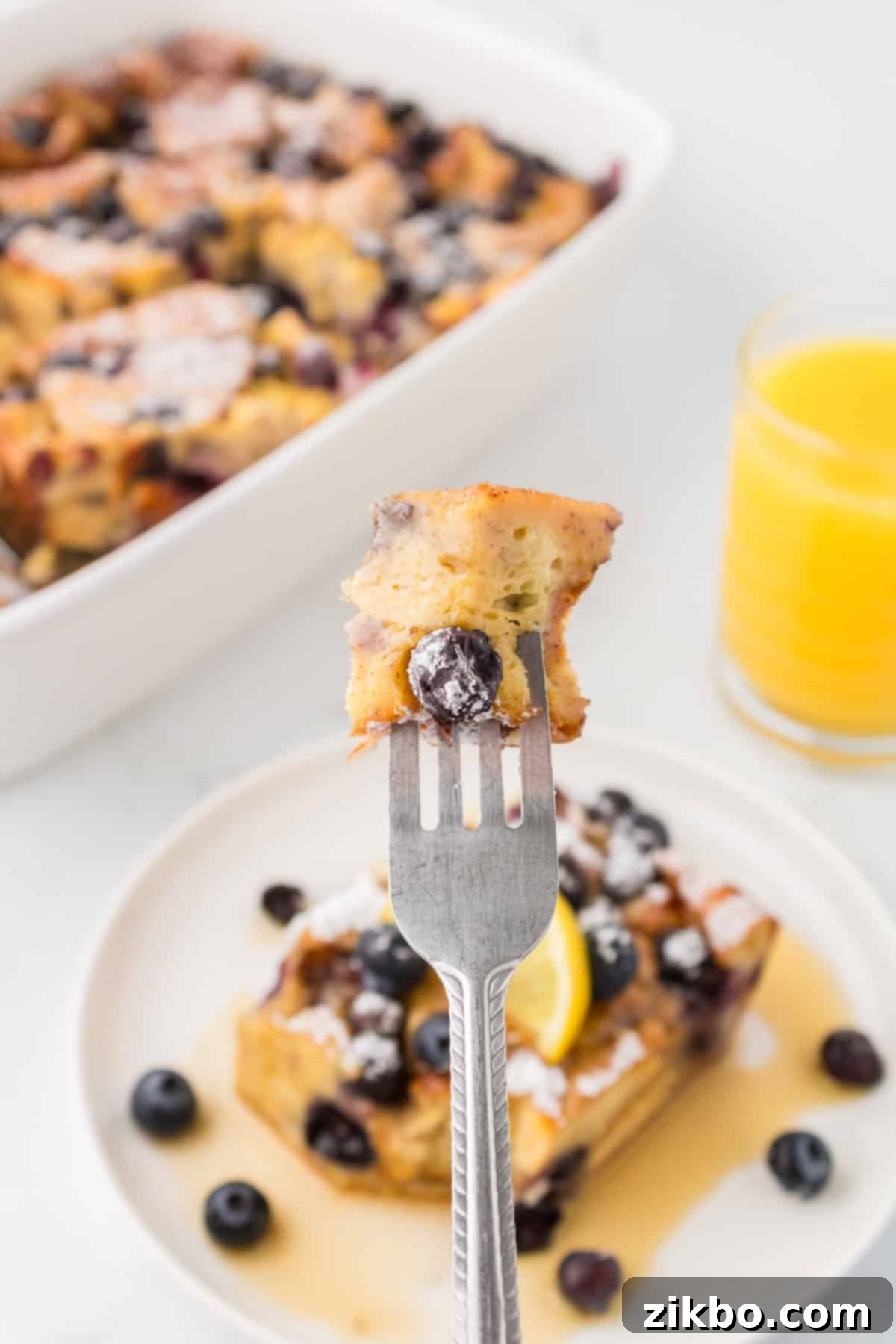

Clever Substitutions to Keep You Cooking
Life happens, and sometimes you don’t have every ingredient on hand. Here are some simple substitutions to ensure your French toast casserole is always a success:
- Half-and-Half Substitute: As mentioned, if you’re out of half-and-half, you can easily create your own blend. For the 3 cups called for in this recipe, simply use 1 ½ cups of whole milk combined with 1 ½ cups of heavy cream. This will achieve a similar richness and consistency for your custard.
- Frozen Fruit: Fresh blueberries are delightful, but frozen blueberries (or other frozen fruit like raspberries or mixed berries) can certainly be used! Just be aware that frozen berries, especially when thawed and baked, tend to release more liquid and their color can bleed into the casserole, potentially giving it a slightly bluish or purplish tint. Don’t worry, it will still taste absolutely delicious, though the appearance might be different. You might want to rinse and pat dry frozen berries to minimize color bleed.
Delicious Variations to Customize Your Casserole
One of the best things about this Brioche French Toast Casserole is how easily it can be adapted and customized to your taste or what you have on hand. Get creative with these delicious variations:
- Seasonal Fresh Fruit: Beyond blueberries, the possibilities are endless!
- Summer Delights: Swap for sliced strawberries, blackberries, or a mix of berries.
- Autumn Flavors: Add diced apples (Gala, Honeycrisp, or Granny Smith work well) or pears, perhaps tossed with a little extra cinnamon.
- Tropical Twist: Sliced bananas pair wonderfully with a hint of coconut extract.
You can use a single fruit or combine two or more for a truly unique flavor profile.
- Chocolate Lover’s Dream: If you want your breakfast to be utterly decadent, chocolate is the answer!
- Chocolate Chips: Stir in milk chocolate, dark chocolate, or white chocolate chips (especially delicious when paired with raspberries!).
- Chocolate Chunks: For bigger, meltier pockets of chocolate.
- Nutella Swirl: Dollop spoonfuls of Nutella over the bread layers before pouring the custard, then swirl gently with a knife.
- Crunchy Nuts & Seeds: Adding nuts brings a wonderful textural contrast.
- Classic Pairings: Chopped pecans or walnuts add a rich, earthy flavor. A “Banana Nut” version with sliced bananas and walnuts is a delightful combination.
- Almond Boost: Sliced almonds or slivered almonds can be sprinkled over the top during the last 15 minutes of baking for a golden, toasty crunch.
- Brown Sugar Streusel Topping: For an extra layer of sweetness and a delightful crunch, create a simple streusel topping.
- How to Make: Before baking, combine ¼ cup packed brown sugar, 2 tablespoons cold butter (cut into small pieces), and 2 tablespoons all-purpose flour (optional, for a thicker crumb). Use your fingers to rub the butter into the sugar and flour until crumbly.
- Application: Sprinkle this mixture evenly over the top of the casserole just before baking. This will create a caramelized, crunchy layer. Add a few chopped nuts to the streusel for bonus points!
- Cream Cheese Swirl: For a rich and tangy element, soften 4 ounces of cream cheese, beat it with 2 tablespoons of sugar and a splash of vanilla, then dollop it over the bread layers and swirl gently before adding the custard.

Recipe FAQ’s
Should you dry out brioche before making French toast casserole?
Yes, absolutely! Drying out your brioche bread is a crucial step for a successful French toast casserole. If you’re using a day-old loaf, it might already be dry enough. However, if your brioche is fresh and soft, you should definitely dry it out before using. This allows the bread cubes to act like sponges, fully absorbing the custard mixture without becoming mushy or soggy during baking. You can achieve this by cutting the bread into cubes and leaving them exposed to the open air for several hours or overnight, or by lightly toasting them in the oven (see the “Choosing Bread” section for detailed instructions).
What kinds of bread are best for making French toast casserole?
For both traditional French toast and a baked casserole, the type of bread is incredibly important for the final texture and flavor. You want a sturdy, dense bread that can withstand a good soak without disintegrating. While almost any slightly stale bread can work in a pinch, the best options include: brioche (our top recommendation for its richness and tender crumb), challah (another excellent, eggy bread), French bread (like a baguette, for a chewier texture), and sourdough (for a delightful tang). These breads hold their shape well and absorb the custard beautifully, resulting in a perfectly custardy interior.
Why is my French toast casserole soggy?
A soggy or “wet” French toast casserole is a common issue that usually stems from a few key factors:
- Using Fresh, Soft Bread: If your bread isn’t dry or stale enough, it won’t properly absorb the custard, leading to a watery result.
- Insufficient Soaking Time: The bread needs adequate time to soak up the liquid. A minimum of one hour is necessary, but an overnight soak yields the best, most custardy texture.
- Too Much Liquid or Too Little Bread: An imbalance in the bread-to-custard ratio can result in excess liquid that doesn’t fully bake out.
- Not Baking Long Enough: The casserole might simply need more time in the oven for the egg mixture to set completely. Ensure the center is firm and not jiggly.
- Oven Temperature Issues: An oven that’s too low might not cook the casserole through, or one that’s too high might brown the top before the inside is done. Ensure your oven is calibrated correctly.
Following the tips for drying bread and proper soaking time will largely prevent sogginess.
Can I make this Brioche French Toast Casserole gluten-free?
Yes, you absolutely can! Simply substitute the regular brioche bread with a high-quality gluten-free brioche or other sturdy gluten-free bread. Look for brands that offer a denser texture, as very light gluten-free breads might become too mushy. Follow the same drying-out instructions for the gluten-free bread to ensure optimal absorption.
Can I make this recipe dairy-free?
Yes, with a few adjustments, this casserole can be made dairy-free. Substitute the half-and-half with a dairy-free alternative like full-fat canned coconut milk (for richness), or a blend of dairy-free milk (like almond or oat milk) and a dairy-free cream alternative. Ensure your brioche bread is also dairy-free (some brioche recipes contain butter or milk, so check labels), or use another suitable dairy-free bread like a challah or French loaf made without dairy.
If you loved this recipe for Brioche French Toast Casserole, please let me know by leaving a 5-star review in the comments below! Your feedback is incredibly valuable. You can also tag me on Instagram @dashfordinner and share your beautiful creations. Happy cooking!
Brioche French Toast Casserole Recipe
This simple, make-ahead recipe for Brioche French Toast Casserole is the easiest way to make French toast for a crowd – no dipping needed! Buttery brioche bread is soaked in an easy custard mixture, then baked until golden brown and drizzled with maple syrup.

- Course: Breakfast
- Cuisine: American
- Prep Time: 25 minutes
- Soaking Time: 1 hour (up to overnight)
- Cook Time: 45-55 minutes
- Total Time: 1 hour 10 minutes (plus soaking)
- Servings: 8 servings
- Calories: 432 kcal per serving
- Author: Dorothy Bigelow
Equipment:
- 9×13″ Baking Dish (23x33cm)
- Large Mixing Bowl
- Whisk
- Spatula or Wooden Spoon
Ingredients:
For the Casserole:
- 1 loaf Brioche bread, stale, cut into 1 ½” cubes (approx. 14 ounces)
- 2 cups blueberries (fresh or frozen, or fruit of choice)
- 6 large eggs
- 3 cups half and half (or 1 ½ cups whole milk + 1 ½ cups heavy cream)
- ½ cup packed brown sugar
- 1 tablespoon fresh lemon juice
- 1 ½ teaspoons vanilla extract
- 1 ½ teaspoons ground cinnamon
- ½ teaspoon ground nutmeg
For Serving (Optional):
- Powdered sugar
- Maple syrup
- Whipped cream
- Fresh berries
Instructions:
- Grease a 9×13” (23x33cm) baking dish thoroughly.
- Place half of the cubed brioche bread into the bottom of the baking dish, spreading it in an even layer.
- Sprinkle 1 cup of the blueberries (or your chosen fruit) evenly over the first layer of bread cubes.
- Add the remaining bread cubes over the blueberries, then scatter the remaining blueberries on top.
- In a large bowl, whisk together the eggs, half and half, brown sugar, lemon juice, vanilla extract, cinnamon, and nutmeg until well combined and smooth.
- Pour the egg mixture evenly over the bread and blueberries in the casserole dish. Use a spatula or wooden spoon to gently press down on the bread cubes, ensuring they are fully submerged and soaking in the liquid.
- Cover the dish tightly with plastic wrap or foil. Refrigerate for at least 1 hour, or for the best results, allow it to soak overnight (8-12 hours). The bread needs to fully absorb the liquids before baking.
- When you’re ready to bake, place the cold baking dish into a cold oven. Set the oven temperature to 350ºF (177ºC) and allow it to preheat gradually with the casserole inside. This prevents temperature shock and potential cracking of your dish. (Alternatively, allow the dish to come to room temperature for 30-60 minutes before placing into a preheated oven.)
- Once the oven has preheated, start the timer. Bake the casserole uncovered for 45-55 minutes, or until the egg mixture is cooked through (no longer runny in the center) and the surface is beautifully golden brown. If the top begins to brown too quickly, you can loosely tent the dish with aluminum foil.
- Remove from the oven and let rest for a few minutes. Serve warm with your desired toppings such as powdered sugar, maple syrup, whipped cream, or extra fresh berries.
Notes:
- Stale Bread is Key: For the best results, use stale or dry brioche bread. If your bread is fresh, cut it into 1 ½-inch cubes and bake on a baking sheet at 275ºF (135ºC) for 5-15 minutes until crusty but not browned. This ensures maximum liquid absorption.
- Half-and-Half Substitute: If you don’t have half-and-half, combine 1 ½ cups of whole milk with 1 ½ cups of heavy cream to yield 3 cups.
- Preventing Temperature Shock: Placing a cold baking dish into a cold oven and allowing it to preheat gradually with the oven helps prevent cracking.
- Freezing Instructions: This casserole can be frozen unbaked or baked. For unbaked, assemble, cover tightly, and freeze. Thaw overnight in the fridge before baking. For baked, cool completely, slice, wrap, and freeze. Thaw and reheat individual portions.
Nutrition (per serving):
- Calories: 432 kcal
- Carbohydrates: 43g
- Protein: 13g
- Fat: 24g
- Saturated Fat: 13g
- Polyunsaturated Fat: 1g
- Monounsaturated Fat: 4g
- Trans Fat: 0.01g
- Cholesterol: 244mg
- Sodium: 307mg
- Potassium: 223mg
- Fiber: 1g
- Sugar: 21g
- Vitamin A: 909IU
- Vitamin C: 5mg
- Calcium: 160mg
- Iron: 1mg
Please note that some of my blog posts here at Dash for Dinner may contain affiliate links. If you make a purchase through these links, I will get a small commission at no additional cost to you. Please see my Disclaimer for more information.
